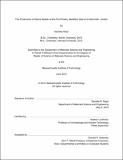| dc.contributor.advisor | Heather Lechtman | en_US |
| dc.contributor.author | Raad, Danielle (Danielle Ranwa) | en_US |
| dc.contributor.other | Massachusetts Institute of Technology. Department of Materials Science and Engineering. | en_US |
| dc.coverage.spatial | a-jo--- | en_US |
| dc.date.accessioned | 2015-09-17T19:08:21Z | |
| dc.date.available | 2015-09-17T19:08:21Z | |
| dc.date.copyright | 2015 | en_US |
| dc.date.issued | 2015 | en_US |
| dc.identifier.uri | http://hdl.handle.net/1721.1/98733 | |
| dc.description | Thesis: S.M., Massachusetts Institute of Technology, Department of Materials Science and Engineering, 2015. | en_US |
| dc.description | Cataloged from student-submitted PDF version of thesis. | en_US |
| dc.description | Includes bibliographical references (pages 175-180). | en_US |
| dc.description.abstract | This thesis describes the results and findings of an investigation of stone bead production at el-Hemmeh, a Pre-Pottery Neolithic (PPN) site in Jordan. The PPNA in the Near East is uniquely characterized by the invention of agriculture and a transition to a sedentary lifestyle, and has therefore been the focus of much research in the region. El-Hemmeh uniquely exhibits multiple phases of occupation during the Pre-Pottery Neolithic A and again during the Late Pre-Pottery neolithic B, and so presents an opportunity to track changes over time at a single site and to highlight aspects of technological style in the PPNA. Stone beads and raw stone material from both the PPNA and LPPNB at el-Hemmeh are analyzed in this thesis. Patterns of typology, color and material are systematically explored, and manufacturing methods are reconstructed based on the close examination of perforations, polishing, and tool marks on ten PPNA beads carefully selected as case studies. The typology of PPN stone beads at el-Hemmeh falls into place with a regional range of shapes and sizes, although I propose here the establishment of a distinct category of rectangular beads. These rectangular beads may have one or two perforations, are only found in the PPNA, only made of greenstone, and may have a distinct cultural significance. Selection of raw material seems motivated primarily by color considerations, and color in the LPPNB sees a shift from green to red. Stone bead production at el-Hemmeh is one characterized by local production influenced by a regional style and motivated by social and cultural developments. | en_US |
| dc.description.statementofresponsibility | by Danielle Raad. | en_US |
| dc.format.extent | 200 pages | en_US |
| dc.language.iso | eng | en_US |
| dc.publisher | Massachusetts Institute of Technology | en_US |
| dc.rights | M.I.T. theses are protected by copyright. They may be viewed from this source for any purpose, but reproduction or distribution in any format is prohibited without written permission. See provided URL for inquiries about permission. | en_US |
| dc.rights.uri | http://dspace.mit.edu/handle/1721.1/7582 | en_US |
| dc.subject | Materials Science and Engineering. | en_US |
| dc.title | The production of stone beads at the pre-pottery neolithic site of el-Hemmeh, Jordan | en_US |
| dc.type | Thesis | en_US |
| dc.description.degree | S.M. | en_US |
| dc.contributor.department | Massachusetts Institute of Technology. Department of Materials Science and Engineering | |
| dc.identifier.oclc | 920875034 | en_US |
